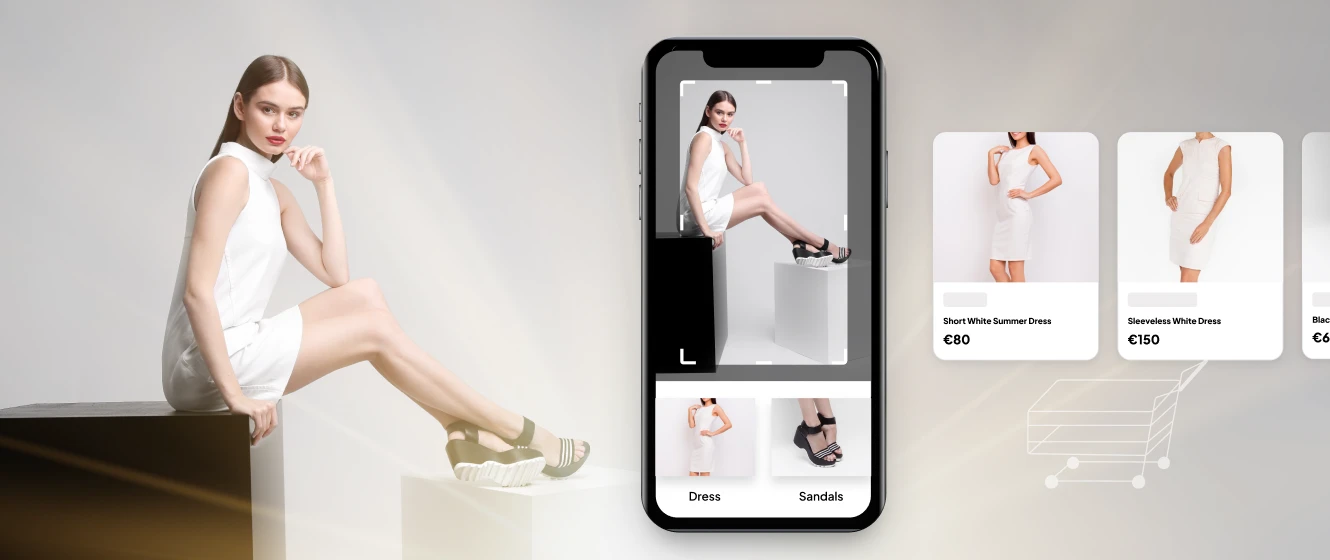
Seamless online shopping through Visual Search
The retail landscape has changed significantly in the past year, moving almost entirely to the online space. Global e-commerce sales are expected to hit $6.5 Trillion by 2023, with more than half of the purchases being made through mobile devices in 2021*. Replacing brick and mortar stores with virtual experiences drives the need for an interactive, seamless online shopping experience that can rival in-person interaction. Visual Search is an emerging machine learning tool with diverse applications that can be used to innovate and improve the existing landscape.
Visual Search is designed to mimic the human understanding of “similar items”, by considering two products similar if they have the same shape, color, pattern, or material. It can be used to retrieve, or recommend similar items to a product, being often simply termed a recommender, or a recommendation engine due to this. Visual Search operates in the visual space, taking as input images and searching for other images that are similar to the input.
Visual Search Applications
Visual Search is a highly versatile technique that can be used in numerous applications in the e-commerce space, with many examples currently being employed in the fashion retail market. The continuing rise of social media and influencer culture drives the need for users to stay on top of fashion trends and quickly find the most fashionable pieces worn by their favorite influencers. Due to this, the most common application of Visual Search in recent years has been “Shop the look”, through which an image of an outfit is used to then identify the exact clothing items worn in the image. The user can upload an image from Instagram or from their camera roll and have the Visual Search engine identify the exact clothing items and redirect the user to the store to purchase the items. “Shop the Look” can be tailored to a specific brand or it can include multiple brands, using the full retail catalog.
As an extension of “Shop the Look”, Visual Search can also be used to recommend similar products in an effort to offer diversity, while still being able to not stray too far from the original search. Similar product recommendations can be based on an uploaded image or can be used on the website purchase page for the product. These recommendations can be used to keep the user engaged despite out-of-stock products, or to offer alternatives.
In an effort to increase basket size, complementary product recommendations have been created, recommending pieces that go together with the chosen fashion item. Although recommendations from past purchases have been used for years in retail websites, machine learning customizes the experience by recommending stylist-grade complementary pieces. By also integrating user information and purchase history, a personalized artificial intelligence stylist can be created to recommend tailored collections to the user.
Visual Search can also be used to completely replace textual search, driving product discovery through visual associations. The user can be taken through a visual quiz, easily pinpointing the specific items he is searching for, while not being as specific as uploading an exact image of the item. The National Retail Federation has found that nearly 80% of online shoppers believe that new technologies and innovations improve their shopping experiences, with 61% of shoppers believing the most important factor in a website is making products easy to search and find*.
Examples of fashion brands implementing Visual Search in their website shopping experiences include Prettylittlething, ASOS, Marks and Spencer, Forever 21, BooHoo, and many more. Fashion retail platforms like Neiman Marcus and Farfetch have also implemented Visual Search on their more diversified catalog.
The above examples have focused solely on the applications of Visual Search in the fashion retail market. However, the technology can be applied effectively to any retail market, from furniture to food recommendations. Wayfair uses Visual Search to recommend similar or complementary furniture items, while Amazon’s Image Search is able to process its entire catalog to find the exact item that you want.
Conclusion
As the online space continues to grow, we move to a more immersive and seamless online shopping experience fueled by the deep learning revolution. Visual Search is one of the many tools in the machine learning arsenal that can be employed to streamline product search, improve product discovery, increase basket size and provide a more valuable overall experience to the user.
Here at Arnia, we use Visual Search in the Fashion, Furniture, and Food industries. We leverage deep learning and vast amounts of data to train accurate and fast models that can be fully customized to specific project needs.
* Statistics in the article are provided by Statista and the National Retail Federation.
Latest event
-
May 2, 2023
See you at the Meet Magento Romania 2023 Conference
We are happy to be present at the Meet Magento Romania 2023 conference, which will take place next Monday, May 8th in Cluj-Napoca, Romania. The event is organized by Zento and will be hosted at Grand Hotel Italia, the premium venue that hosted Meet Magento Romania in 2018, 2017 and 2015. Meet Magento is a […]
 ?>
?>